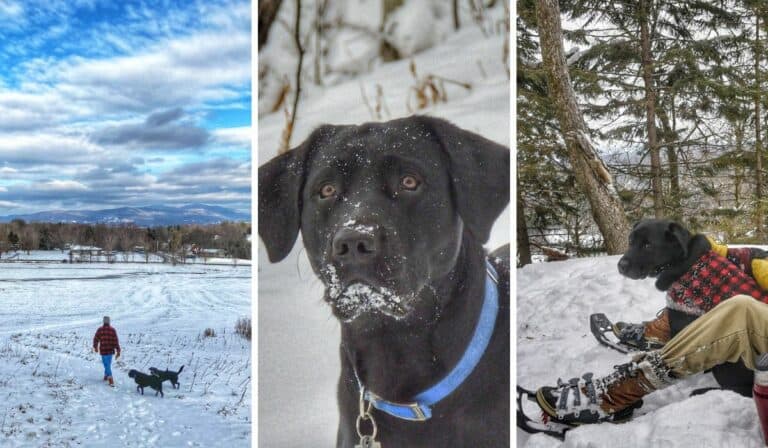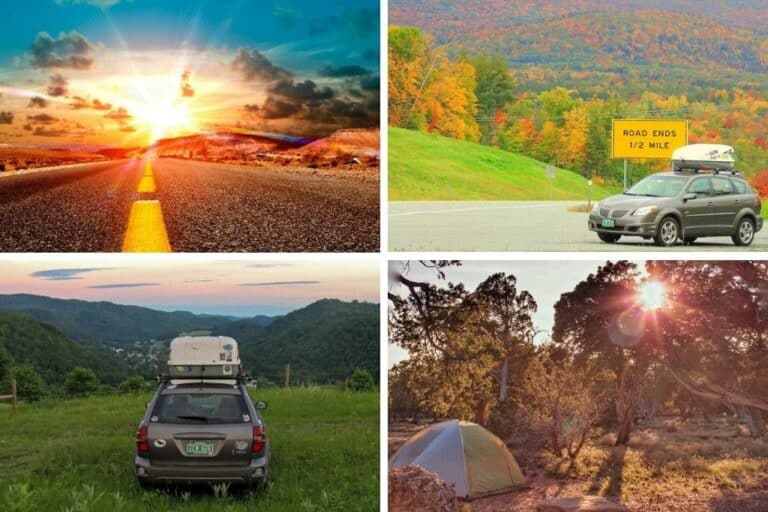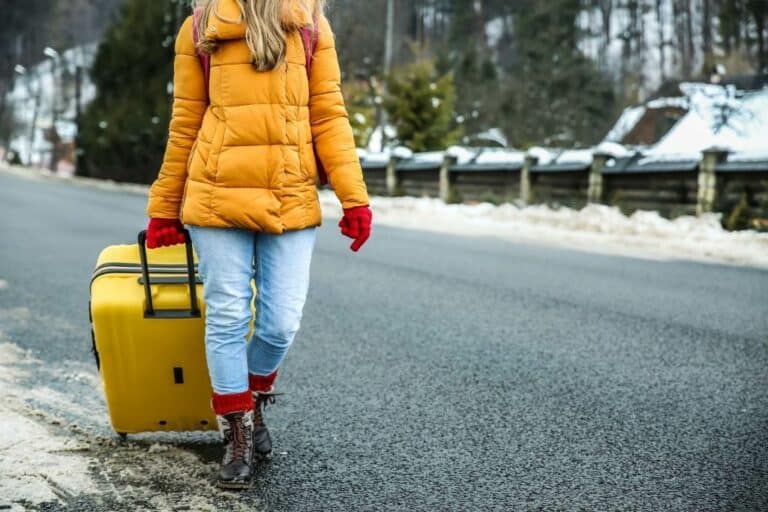Camping 101: A Complete Guide to Camping for Beginners
Note: Advertising is how we keep this site free for you to enjoy, and we earn a commission from affiliate links that may be included in this post. Thank you for supporting Back Road Ramblers!
Camping bliss is telling ghost stories around a crackling fire as loons call in the distance.
Waking up with the birds to quietly sip coffee as the sun rises over the horizon.
Spending a full day outdoors adventuring before coming ‘home’ to a cozy tent.
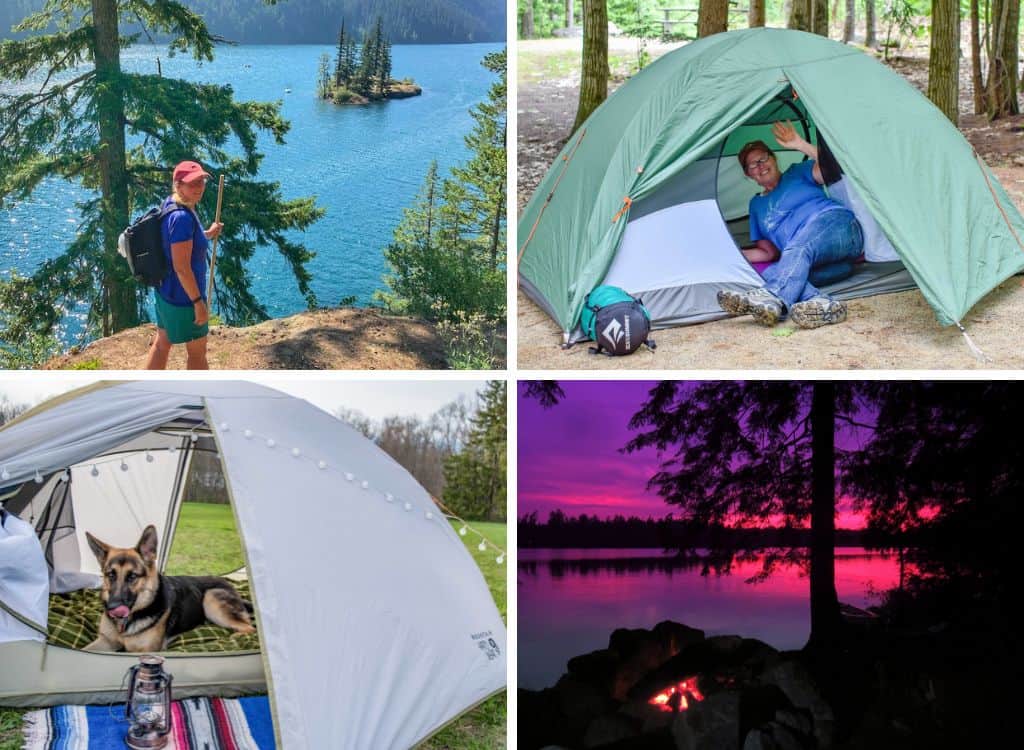
Those quiet, peaceful moments make camping one of our favorite ways to enjoy a weekend away or a mega road trip, but we’ll be the first to admit that not every moment is quiet.
Or Peaceful.
There was the time our camping neighbor’s dog got sprayed by a skunk, and the stench permeated every inch of our gear.
Or when we forgot one of our tent poles and had to spend the night curled up in our tiny car. Or when we pitched our tent in a low spot, only to witness a massive storm that left us sleeping in a small lake.
Those camping struggles are the ones we laugh about now, and despite our not-so-perfect adventures in the wilderness, we still love going camping!
Not only is it the best way to immerse ourselves in a wilderness experience, but it’s also one of the cheapest ways to travel.
The best way to become a better camper is to go camping! Your first camping trip won’t be perfect, but the more you get out there, the easier it will be!
Here’s a complete guide to camping for beginners so you can head into the woods confidently for your first camping trip.
Table of Contents
What Type of Camper Are You?
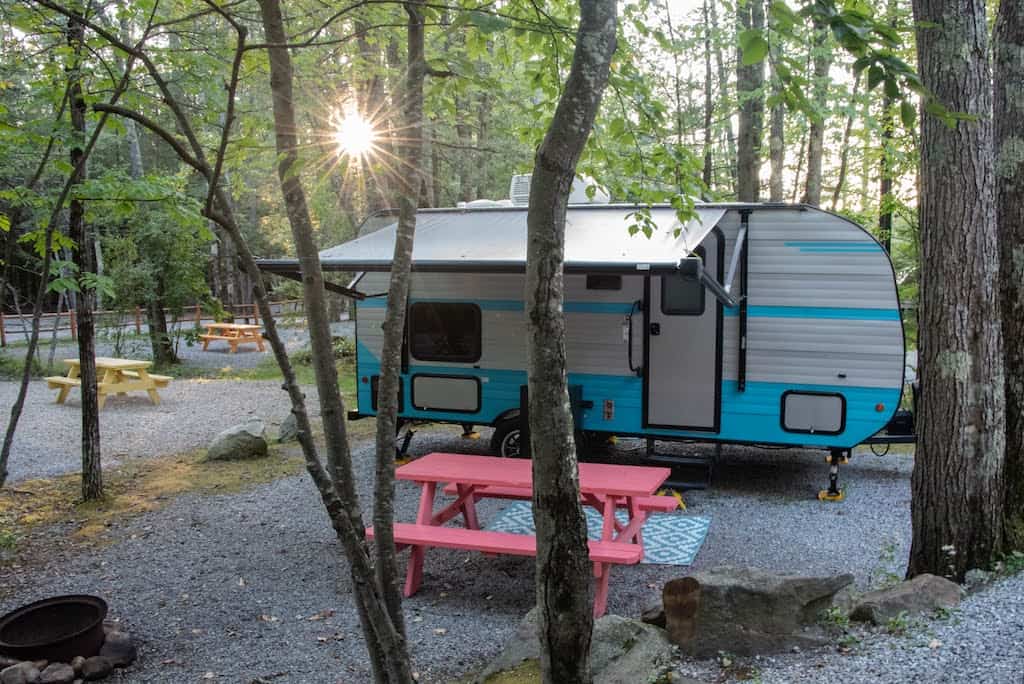
Want to pick a fight? Head to your nearest outdoor gear store and try talking about what constitutes ‘real’ camping.
You’ll hear that it’s not real camping unless you hike a few miles with your gear and set up camp in a secluded wilderness.
Or that sleeping in a vehicle or a remote cabin doesn’t count as ‘camping’.
Or my favorite — it’s not camping unless you’re uncomfortable!
The truth is that there are as many types of camping as there are people who go camping. Choose the path that fits your lifestyle and your budget!
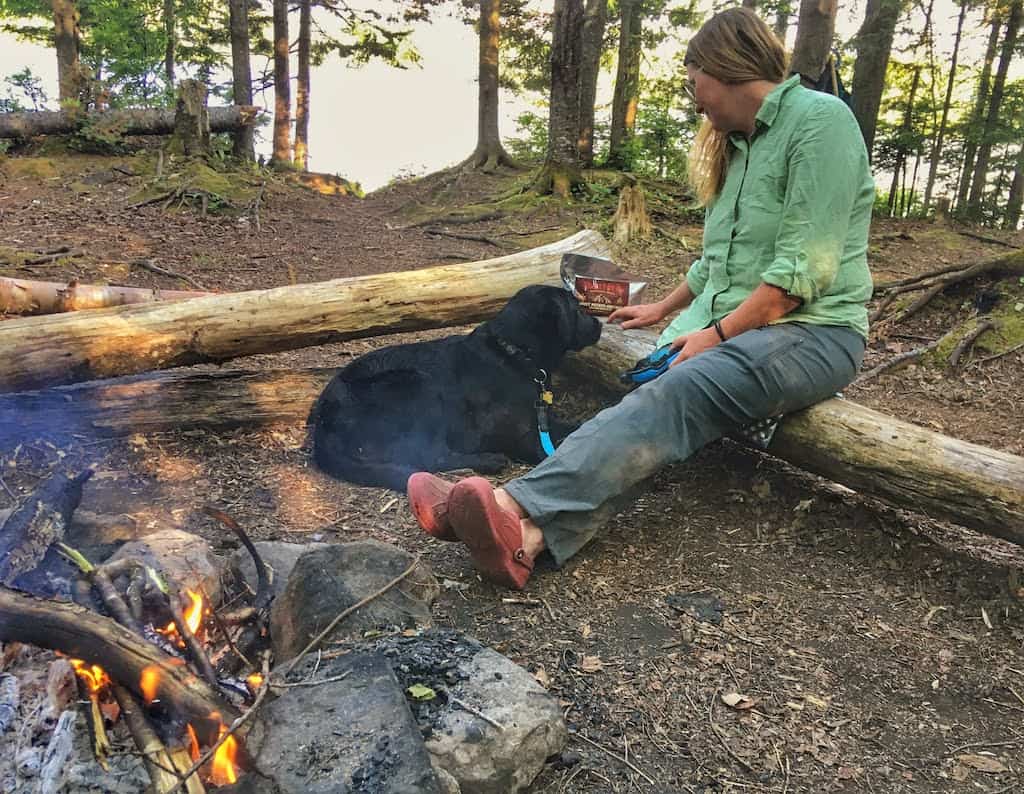
- Backpacking: Hiking with all your gear to set up your tent or hammock in backcountry campgrounds or deep in the wilderness. This requires specialized gear and is generally not recommended for beginners.
- Car camping: Driving to a drive-up campground and setting up your tent or hammock next to your car. Basic amenities, such as a picnic table, fire pit, potable water, and bathrooms, are usually provided. This is usually how we camp!
- RVing and van camping: Driving a recreational vehicle to a campground or a dispersed camping area and sleeping in your vehicle.
- Boondocking: Boondocking involves bringing your self-contained vehicle to a ‘dry’ campsite without any amenities. This is great for vehicles with water, electricity, and a toilet.
- Tent camping: Simply means that you’re sleeping in a tent.
- Hammock camping: Sleeping in a hammock. We’ve tried it and written about it, but we camp with dogs, so it isn’t the best fit for us.
- Glamping: A wilderness experience without all the gear! With glamping, you get to sleep in a real bed, and you may even have a kitchen and a bathroom. It’s downright luxurious and one of our favorite ways to enjoy the outdoors.
My Personal Camping Philosophy
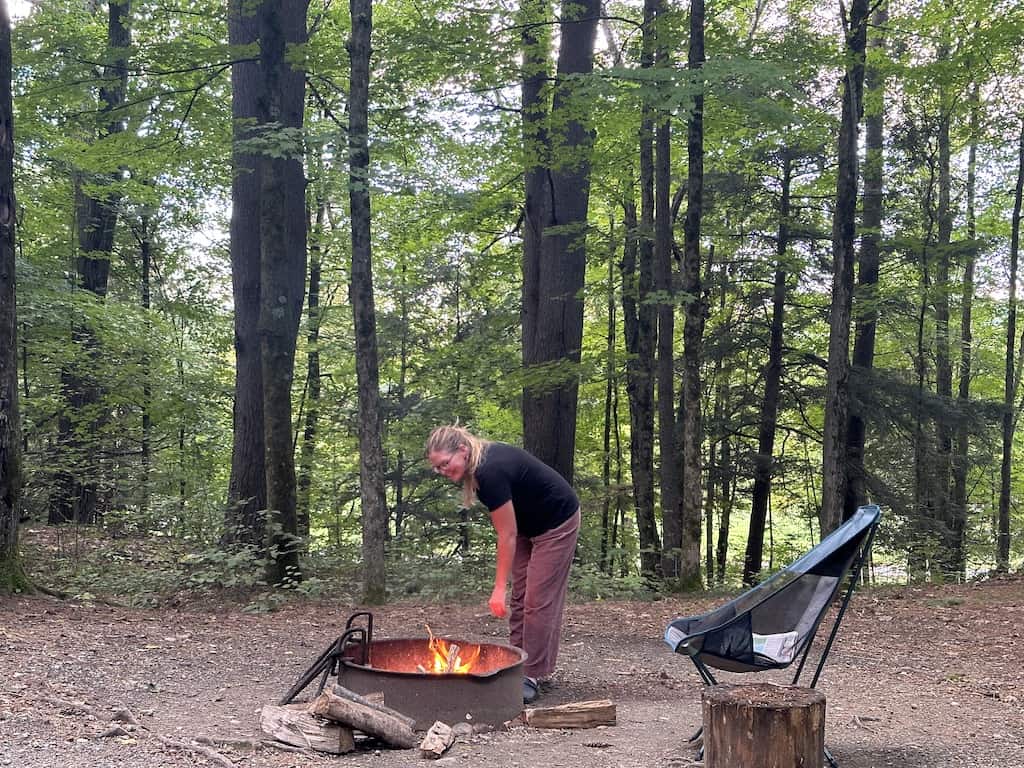
Just so you know where I’m coming from, I wanted to tell you a bit about my camping style. You may read this and decide that you don’t want to follow my advice after all!
I didn’t grow up camping or doing anything ‘outdoorsy’, but I fell hard for hiking and camping in my early twenties. I have done some backpacking, but I prefer not to carry all my gear on my back these days.
I am pushing 50, and while I still love camping and the outdoors, I split my vacations about 50/50 between camping in campgrounds (car camping) and glamping. I’m into comfortable simplicity, and I often camp with my dogs.
I don’t buy the most expensive gear, but I also don’t buy gear from discount stores.
I cook simple, mostly vegetarian meals when I go camping, and I still stay at campgrounds whenever I travel long distances. I believe in budget travel, and camping makes it easier to embark on long trips without spending all my money.
Finally, I love camping solo, but for those trips, I stick to campgrounds where I can get help if I need it.
Where to Go for Your First Camping Trip
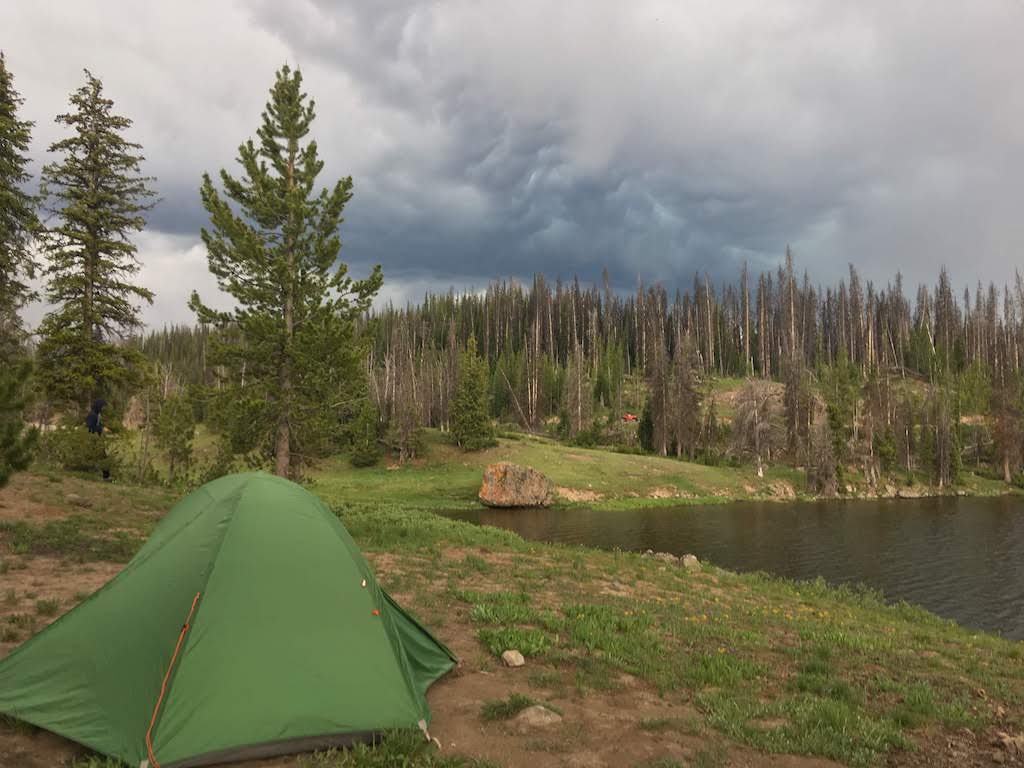
To fall head over heels for camping, you need to do a few trial runs to ensure your gear is in order. I recommend choosing a front-country campground within a few hours of home for a weekend of car camping.
While not every campground requires you to book a site ahead of time, we recommend doing so to minimize anxiety. There’s enough stress in the world without having to worry if you’ll have a place to sleep on your camping trip.
Planning a camping trip is hard work, so be sure to book a campsite for at least two nights! We want all that hard work to be worth it!
Fortunately, finding and booking campsites is pretty easy if you know where to look! Here are some suggestions:
- Your local state parks: Most, but not all, state parks use Reserve America as their booking platform of choice. You should be able to find a link to the reservation platform from the state park’s website. State parks usually have more amenities than federal campgrounds (like flush toilets), and there are state parks out there that rival national parks in natural beauty and recreation opportunities.
- Recreation.gov: This government-run website includes national forest and national park campgrounds, as well as other federally managed campgrounds. I love getting lost on this site, looking for campgrounds.
- The Dyrt: This massive campground database and review site includes information on public and private campgrounds. Use it to find amenities, including cell coverage, read reviews, and browse photos. It’s free to use, but the pro version allows you to find campgrounds even when you don’t have cell service — it’s perfect for camping road trips! Read our overview of The Dyrt Pro to find out why we love it!
Essential Camping Gear for Your First Tent Camping Trip
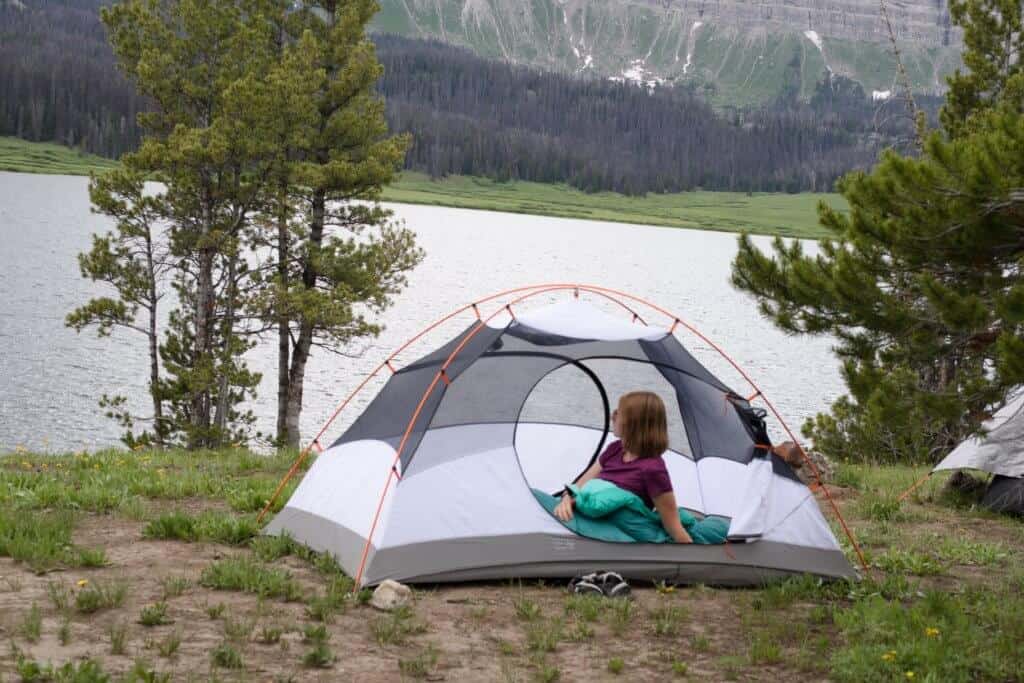
Let’s talk camping gear! When you’re just starting out, I recommend just getting the basics, which boil down to a shelter, a comfortable sleeping system (sleeping bag, pillow, and pad), safety essentials, and your camping kitchen.
Yes, your camping gear will require an initial investment, but look at it this way — a high-end tent that will last for years costs about the same amount as a high-end hotel room for one night. You got this!
Pro gear tip: Become an REI Co-Op member! Your $30 membership lasts a lifetime and comes with tons of benefits, including access to special sales and gear, 10% back annually, and free shipping without a minimum purchase.
Shelter and Sleeping Gear for Camping
Don’t skimp on your tent and sleeping gear. The last thing you want is a tent that leaks during the first rainstorm or a sleeping bag that doesn’t keep you warm!
Yes, when you go tent camping, you’re sleeping on the ground, but modern gear has worked to make the experience more comfortable so that you hardly notice that you’re not actually in a cozy bed for the night.
Choosing Your Tent
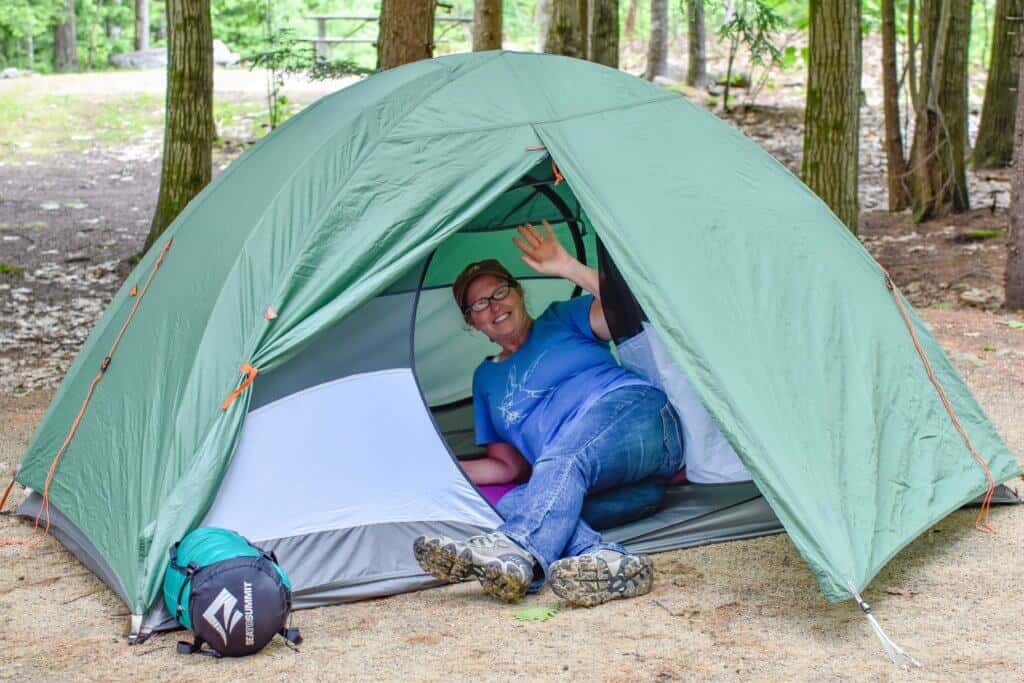
When it comes to choosing the perfect tent, there are a few considerations to keep in mind:
- Will you be strictly car camping, backpacking, or a combination of the two? Tents are one of the heaviest things in your gear kit, so if you think you are going to carry it on your back, buy a backpacking tent.
- Will you be flying with your camping gear? We do this quite often, so we usually buy backpacking gear, even though we rarely go backpacking.
- How many people will you usually go camping with? Tents are sized by the number of people they can fit.
- What seasons will you be camping in? There are three-season tents and four-season tents (for winter camping).
- Will you be camping with dogs? I consider my dogs to be people when deciding which tent to use.
I recommend buying the smallest and lightest tent that meets your criteria, as determined by the questions you answered above.
If you are camping with kids, you may even want to split your shelter requirements into two tents for more versatility.
Here are some tents that I recommend:
- Mountain Hardwear Aspect Tents: We have the older versions of this tent in both the two and three-person configurations. We have been using them for 10 years, and they are not ready to be replaced yet! The two-person version is suitable for three seasons, weighs 3 lbs 6 oz, and features two vestibules for easy entry and exit.
- REI Co-op Half Dome SL 2+ Tent with Footprint: A little heavier and a little cheaper than the Mountain Hardwear tent, this three-season tent is roomier than a traditional 2-person tent, and it comes with a footprint to protect the floor from rocks and sticks.
- Marmot Tungsten 4P Tent with Footprint: This 4-person tent has two doors and vestibules, comes with a footprint, and weighs 7 lbs, 15 oz., and it’s very easy to set up!
Choosing Your Sleep System for Camping
A ‘sleep system’ is just a fancy way of referring to your sleeping pad, sleeping bag, and pillow. It also determines whether you spend the night blissfully snoozing under a canopy of stars or tossing and turning while miserably waiting for the sun to come up.
As with choosing the perfect tent, ask yourself a few questions before buying your sleep system:
- Do you generally sleep warm or cold?
- Will you be cozying up with a partner?
- What temperature range will you be sleeping in?
Choosing Your Sleeping Bag
As with your tent, you should buy the lightest sleeping bag that meets all your criteria.
A down sleeping bag will be lighter and warmer than one with synthetic filling, and you can buy sleeping bags with Responsible Down Standards (RDS) certification, which ensures the humane treatment of geese and ducks throughout the entire down and feather supply chain.
For camping in three seasons here in Vermont, I use a down sleeping bag that is rated to 18 degrees Fahrenheit. I also use a women-specific sleeping bag that is roomier in the hips and has a separate bottom zipper, allowing me to let some cool air in when my feet get hot.
If you will be camping with a partner, you can get two sleeping bags that zip together to create one big sleeping bag.
Here are some sleeping bags that I recommend:
- The North Face Dolomite One Duo Sleeping Bag: This is my choice for couples camping! It’s basically three bags in one, and you can change the configurations based on the temperature. Rated to 15 degrees Fahrenheit, this bag uses synthetic filling and weighs 8 lbs, 13 oz. It’s an affordable choice for car camping.
- Big Agnes Sidewinder SL 20 Sleeping Bag for Women: Weighing just 2 lbs, 10 oz, this lightweight bag is filled with a down/synthetic blend for great loft and warmth down to 20 degrees Fahrenheit.
- NEMO Riff 15 Sleeping Bag: Women’s – A three-season down bag weighing 3 lbs, 2 oz, this down-filled bag is comfortable down to 15°F.
Choosing Your Sleeping Mat
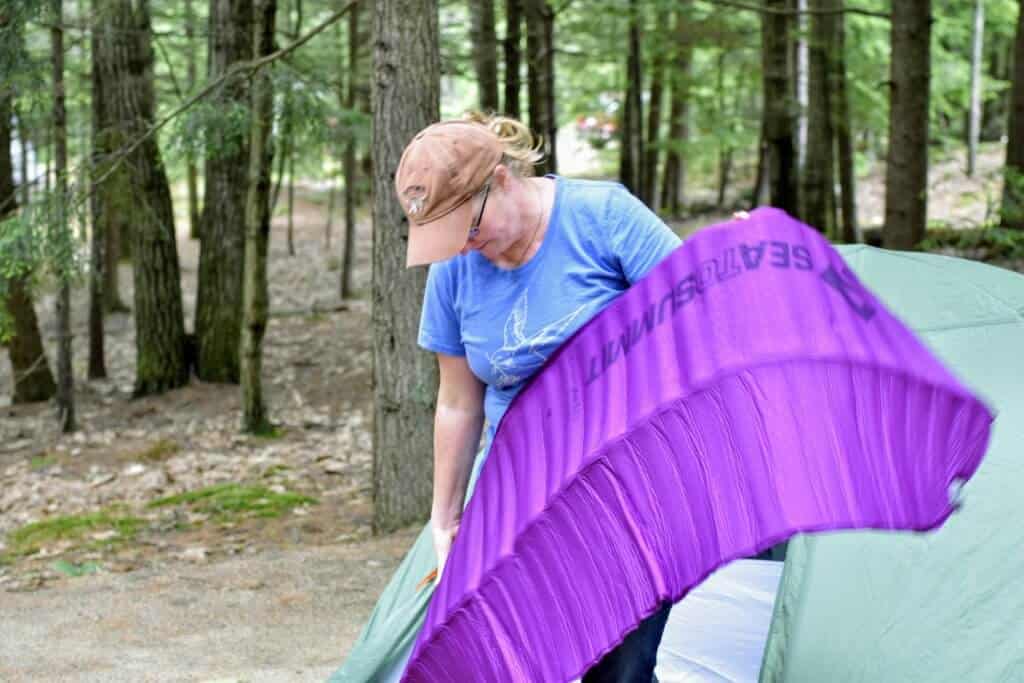
When choosing a sleeping pad for your sleep system, you want to look at a few specifics: weight, thickness, and R-value. R-value measures thermal resistance, or how well the material resists the transfer of heat. The higher the R-value, the more insulation it will provide.
Thicker, warmer sleeping mats will be heavier and more comfortable, and at some point, you may want to buy a sleeping mat for car camping and another for backpacking.
I’ve got a pretty thick, warm sleeping pad that I could take backpacking in a pinch. It’s made all the difference in providing me with a good night’s sleep in the woods!
Here are the sleeping mats I’d recommend:
- Sea to Summit Comfort Plus Self-Inflating Sleeping Mat: My current sleeping pad – I chose the Women’s Comfort Plus because it offered more insulation and support in the hips, where I need it. It has an R-value of 4.0, so it’s suitable for four seasons of camping, and while it’s relatively heavy – 32.6 ounces, I knew I could carry it on shorter backpacking trips.
- Sea to Summit Women’s Ultralight Insulated Air Sleeping Mat: I got this one this year for lightweight summer camping, and I love everything about it (except that it’s a little noisy when you move around at night). It’s just 17 oz, with an R-value of 3.5, and it’s four inches thick!
- Big Agnes Divide Insulated Sleeping Pad: This unisex pad has an R-value of 4, weighs 1 lb, 7 oz, and is 3.5 inches thick. It packs down small and has a smooth, stable sleeping area.
Do You Need a Camping Pillow?
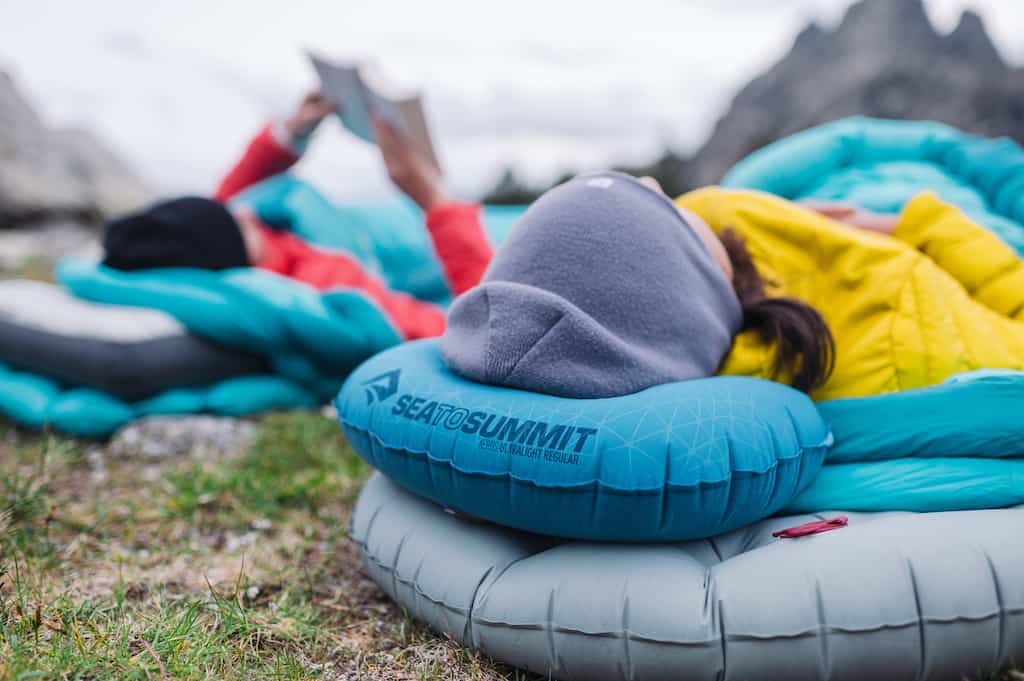
Need is probably too strong a word here. If you’re car camping, you can bring a pillow from home, and if space is tight, you can always use a stuff sack filled with clothes to rest your head on.
I spent years without a dedicated camping pillow, and I lived to tell the tale. Now I use the Sea to Summit Aeros Premium Inflatable Pillow, and I’m not sure if I could live without it anymore. This little thing fits my pocket and weighs just 2.1 oz.
The Aeros Premium features a stretch-knit polyester coating that is way comfier than traditional inflating pillows that scratch your face and make your head bounce around at night.
Even better, the Aeros and all Sea to Summit pillows are compatible with the Pillow Lock System, which keeps your pillow from sliding off your pad during the night. I will never use a bag of clothing for a camping pillow again!
Essential Clothing for Camping

Before you pack up and head out on your next camping trip, make sure the weather suits your clothes (or vice versa). Because, as dads and hikers everywhere like to say, ‘there’s no such thing as bad weather, only bad clothing.’
I won’t pretend to know what your personal style is, but I will offer you some general clothing advice that has nothing to do with style.
Here are a few clothing choices to consider so that you’ll always be prepared:
- Don’t wear cotton: Once cotton gets wet, either from sweat or rain, it takes forever to dry, and it will make you cold. I will occasionally bring cotton pajamas to wear in my sleeping bag on summer nights, but that’s it.
- Instead, wear Merino wool: If I could buy stock in sheep (or have a sheep farm), I would! Merino wicks away moisture from your body, dries fast, and is antimicrobial, so you don’t have to wash it as much. Buy Merino wool layers from Ibex to pack for all of your camping trips in every season.
- Don’t forget Merino socks: Keep your feet warm in the winter and cool in the summer with Merino wool socks from Darn Tough. They are made in Vermont and guaranteed for life!
- Consider convertible pants: I always thought those combination shorts/pants were dorky, but honestly, they’re pretty useful, especially in the spring and fall when the weather is unpredictable.
- Footwear considerations: You’ll need a sturdy hiking shoe for all of your outdoor excursions, plus a dedicated camp shoe for kicking around. I use Crocs. Don’t judge. Optional is a waterproof sandal for water-based activities.
- Think in layers: It’s easy to mix and match lightweight layers to create a system that will work in three seasons. Your base layer will be a t-shirt in the summer and a long-sleeved shirt in the spring and fall. Next, you need an insulating layer for cool days, followed by a waterproof layer to keep out wind and rain. For your bottoms, you shouldn’t need more than a single layer (pants or shorts).
- Outer Layers: Weather in the wilderness, particularly in the mountains, can be unpredictable. You need lightweight clothes that can be swapped on and off at a moment’s notice. For this, you can’t get much better than a down vest or down jacket along with a cozy fleece layer for in-between periods.
- Rain Layers: Bring a waterproof layer so that unexpected storms don’t ruin your trip! We keep a packable rain jacket in the car for weather emergencies.
- Swim layers: I don’t know about you, but we almost always camp near water in the summer, and we never forget our swimsuits and towels!
First Aid and Toiletries
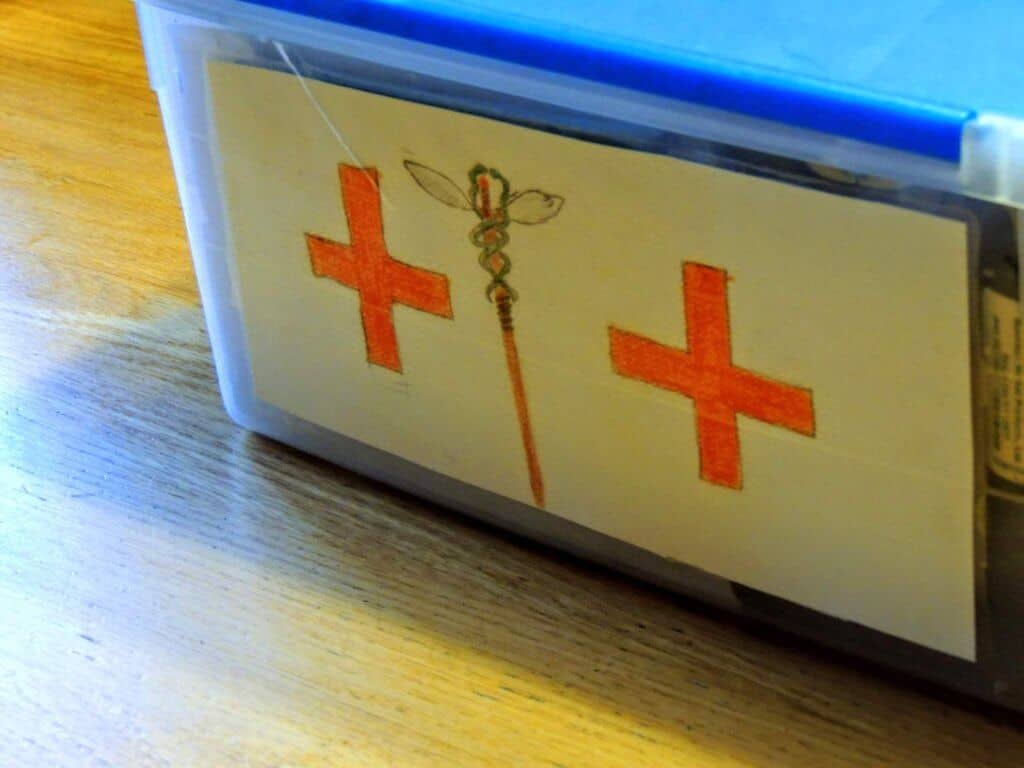
Next, you’ll need to pack some basic items to address minor medical emergencies and maintain personal hygiene. Here’s what to pack in your camping toiletry and first aid kit:
- Bug spray and head net: If you camp in the northeast, these are essential! Our favorite bug spray is Sawyer Picaridin Insect Repellent. Picaridin is an alternative to DEET, and it works great! These Sea to Summit head nets are teeny tiny and will keep you from escaping to your tent when the sun goes down.
- Sun protection: Pack a brimmed hat and reef-safe sunscreen for sunny days.
- Face wipes: For times when you can’t get to the campground bathhouse but still want to feel fresh. YES to Cucumbers face wipes are my absolute favorite!
- Toothpaste, floss, and a toothbrush
- Camp Suds: Biodegradable camping soap that you can use for anything — dishes, face, hair, and clothes!
- Shower stuff: When the grime is overwhelming, keep your fingers crossed that the campground you’re staying at has hot showers. Simply package your at-home products into small bottles to use while camping.
- Quick-dry towels: Cotton towels take forever to dry when camping. Instead, bring these quick-dry towels that absorb tons of water.
- First Aid Kit: When car camping, we bring our full road-trip first aid kit, which prepares us for all minor emergencies, including cuts, burns, bug bites, and sprains. The kit also includes common medications for headaches, colds, and gastrointestinal problems.
- Hand sanitizer, toilet paper, and a small shovel: For bathroom emergencies. Read How to Go to the Bathroom in the Woods for more on this fun topic.
Your Camp Kitchen
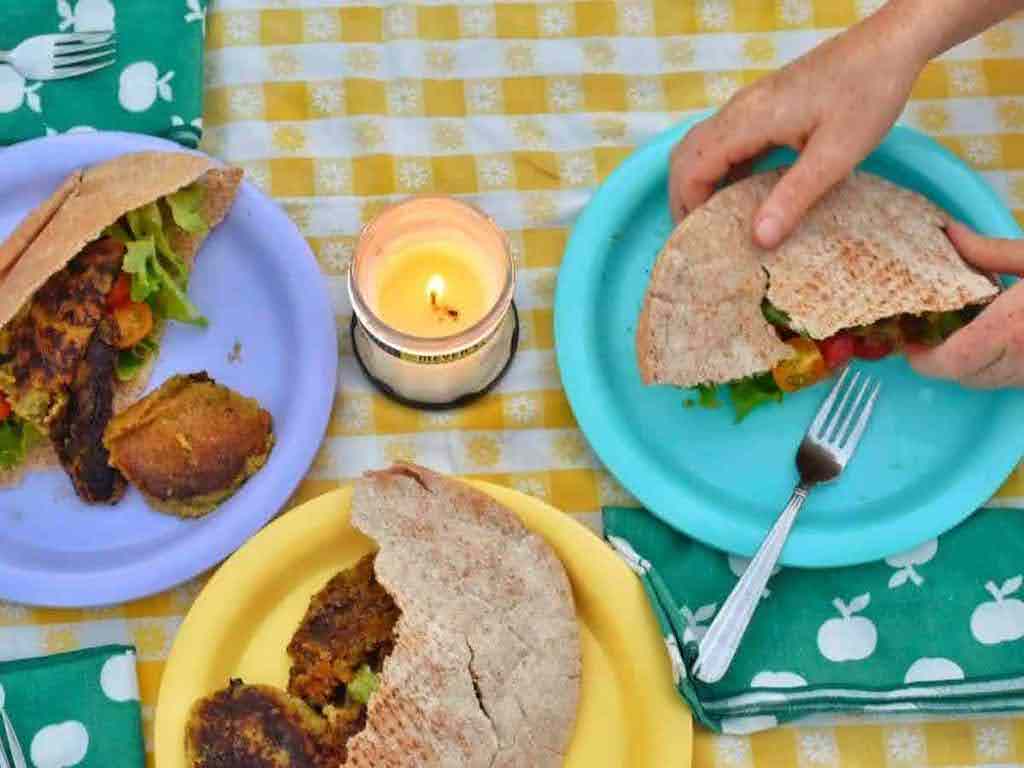
There are many small details that contribute to a perfect camping kitchen.
It’s taken us years of practice to create the perfect camp kitchen setup, but we’ve got it down to a science these days.
Our “kitchen” is actually a big duffel bag that holds all of our cookware and supplies, but a large plastic tub would work too.
Our camping kitchen is very compact since we have to cram everything into our tiny car. It’s even small enough to bring on an airplane (in a checked bag) when we go camping farther from home.
Here’s a complete guide to everything you need to outfit your camp kitchen based on the kitchen setup that we’ve perfected over 20+ years of car camping. It includes recommendations for a camping stove, cookware, tableware, utensils, our favorite cooler, and our dishwashing setup.
Be sure to pack supplies for dishwashing and a spice kit for doctoring up bland meals!
Food for Camping

Once you’ve outfitted your camping kitchen, it’s time to make a meal plan and figure out how to execute it.
Keep your meals simple so you don’t spend all your time at the campsite cooking and cleaning. Bring a whole lot of snacks so everyone in your group can help themselves when they’re hungry.
Here’s what we look for when figuring out our car camping meals:
- Nutritiously balanced, simple meals (we’re not saints, but we try to provide a bit of nutrition).
- Ingredients that are available at most supermarkets across the country.
- Recipes that use only small amounts of perishable ingredients. For the most part, we stay away from meat, dairy, and leafy greens when camping because we don’t want to deal with constantly buying ice for the cooler. Our exceptions are hard cheeses, yogurt, pepperoni, and other dried meats, which can tolerate short periods of less-than-ideal temperatures.
- Recipes that use one or two pans are easy to clean up.
Cooking over an open fire is lots of fun, but if you camp a lot or embark on camping road trips, cooking over a fire quickly becomes a hassle. We save open-fire cooking for special occasions and use the Jetboil HalfGen for most of our camp meals. Don’t forget to pack your propane gas for cooking.
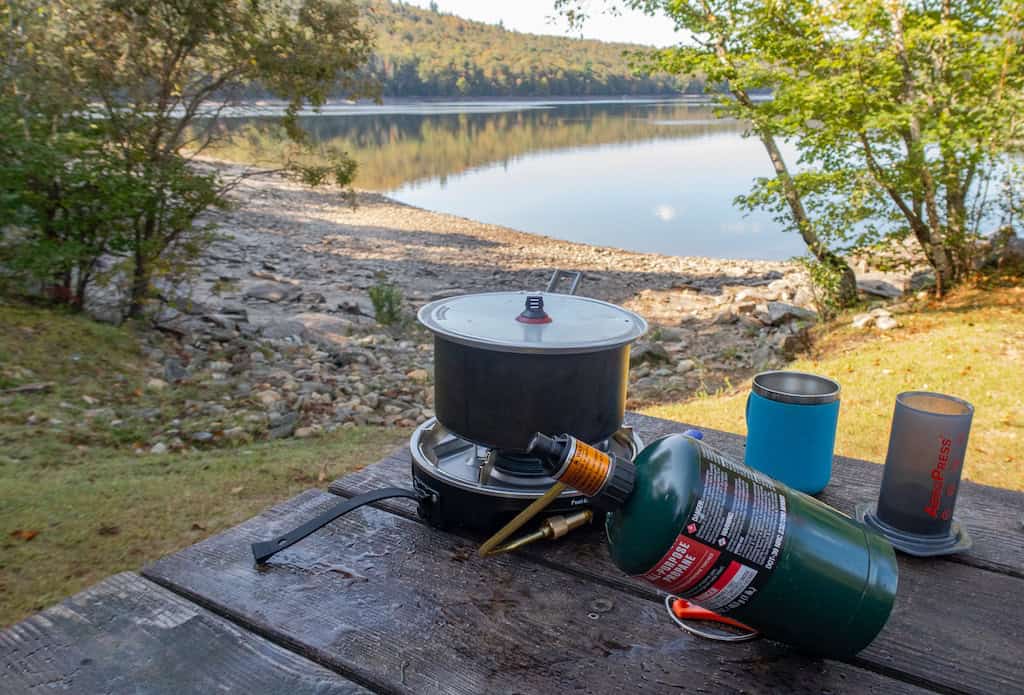
Using a propane stove for camp cooking means that you can have morning coffee in a flash, not to mention simple foods like soup and pasta. Propane is also available at just about every good-sized grocery store.
Based on the above criteria, here’s an overview of 10 of our favorite camp meals for families.
Other Essentials for Camping
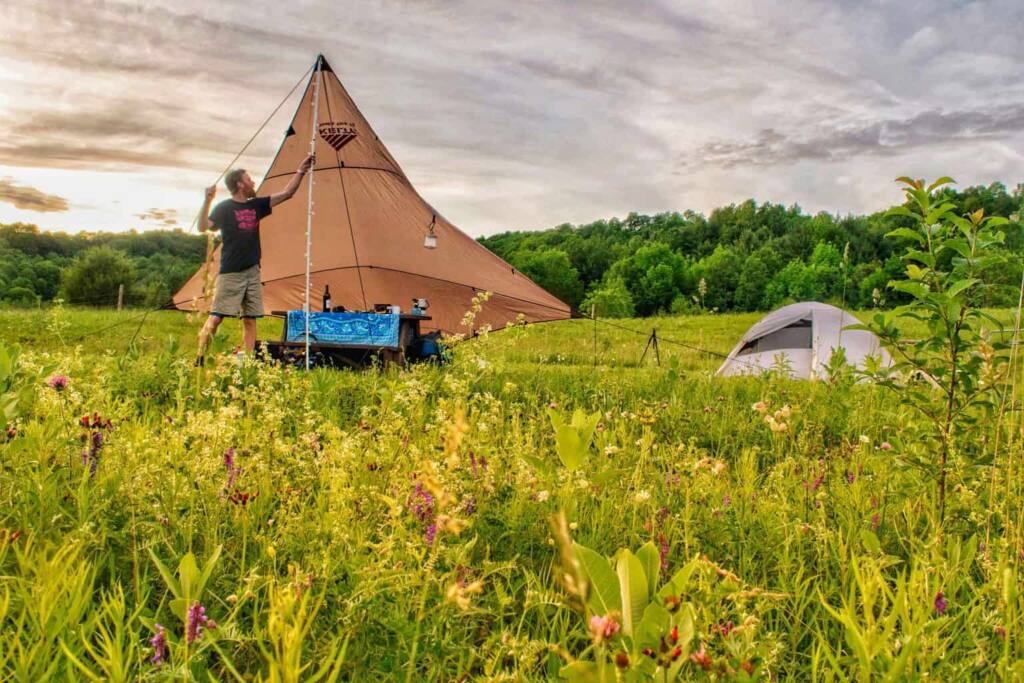
Once you’ve nailed down your basics — shelter, sleeping gear, and gear for food prep, you’re practically done! Now, for some important camping equipment that will make your trip memorable for all the right reasons!
- Lighting: Pack a headlamp for every person in your group as well as some ambient lighting — a lantern, candles, fairy lights, etc.
- Camp chairs: If space is at a premium in your vehicle, invest in lightweight chairs that won’t take up a lot of room. We love these Sunset Chairs by Helinox, and they make chairs that are even smaller, lighter, and cheaper.
- Water filtration system: Most campgrounds provide potable water, but not all of them! And if you’re backpacking, a water filter is a must. We use the Katadyn Gravity BeFree water filter system for most of our camping needs, and we 100% recommend it over smaller systems.
- Water storage: Bring a 32-oz water bottle for everyone in your group, and a storage container like this one so you have access to fresh water at your campsite.
- A kitchen tarp:
- A kitchen tarp: This is listed in our camp kitchen guide, but I wanted to mention it here, too. Cooking in the rain is pretty awful, and we’ve learned to keep a kitchen tarp on hand so we don’t have to. We have been using the Kelty Noah’s Tarp 12 for 10+ years, and it has saved countless camp meals! We set it up right over our picnic table. When the weather is nice, we flip one side over the other so we can soak up the sunshine.
- Paracord: Useful for so many things, including tying up your canoe or your dog, and hanging your laundry.
- Duct tape: So many uses — fix a hole in your tent, cover an almost-blister, repair the bumper on your car…
- Portable power bank: Bring a portable charger so that you can keep your device powered up while camping. My charger will give my phone four extra charges and can also be used to charge my headlamp.
- Trash bags for clean up: We don’t make a lot of trash, and use small grocery bags on most of our trips.
Non-Essential Camping Essentials
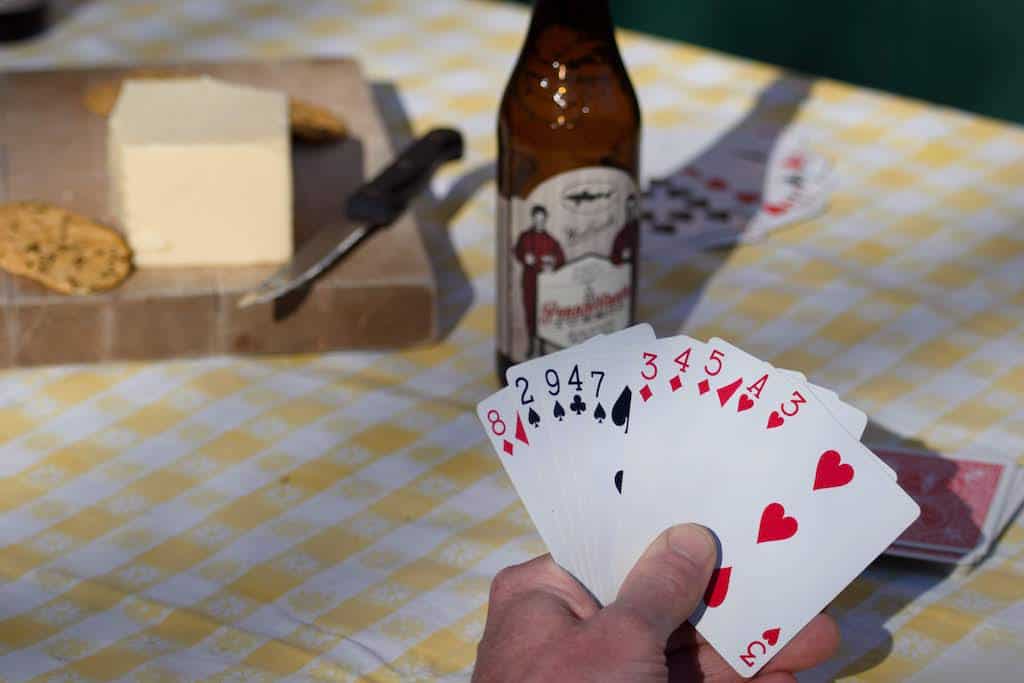
And finally, the category I like to call ‘things to bring for the pure fun of it (and when there’s room in your car)’ — necessities that aren’t necessary but make camping more fun! We’ve also got a guide to creating the ultimate cozy camping setup with non-essential essentials — Home is Where You Pitch it: Cozy Camping 101.
- Board games: We like to bring card games that don’t take up a lot of space — cribbage, Skip-Bo, and Set are our favorites.
- Books, magazines, crossword puzzles, and drawing supplies for downtime
- A camping cocktail kit for mixing up snazzy outdoor drinks
- Things to throw: Baseball, football, Frisbee, etc.
- Fishing gear
Tips for Pitching Your Tent
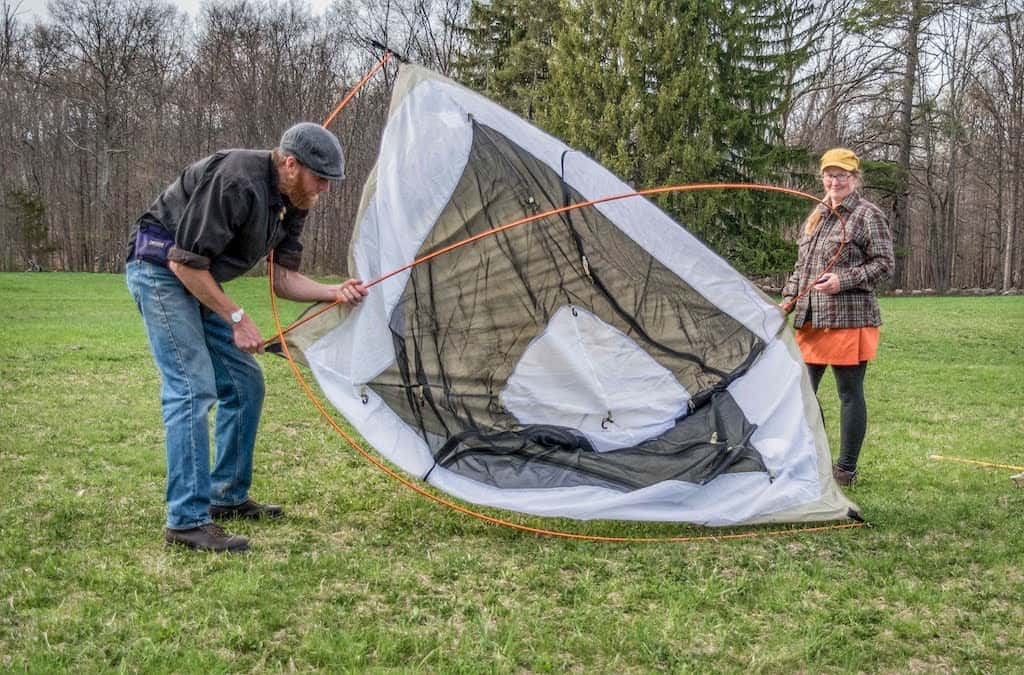
You already know that packing up all that gear is the hardest part of your camping trip. Once you’ve got the car loaded up, you are READY for a memorable camping experience! First things first, let’s get that tent up!
I won’t pretend to know exactly how to set up your tent. I have a hard enough time with my own.
I can, however, offer a few tips that can apply to tent camping in general. Like, don’t set up your tent in a depression that can collect water, even when the skies are clear!
Doing that is as good as a rain dance, and you’ll wake up in a puddle of water ready to go home.
Here are a few more ingenious tips for pitching your tent:
- Look for a flat spot. You might not find one, but that’s the goal. If you have to pitch your tent on a slope, make sure your head is at the top of the slope and your feet are pointing downward.
- Clear rocks, pinecones, and sticks from the spot where your tent will go. For obvious reasons.
- Look up. Check the trees for hanging dead branches, called ‘widow makers’ for a reason.
- If you are using a footprint, be sure it doesn’t stick out past the walls of your tent, which will cause water to collect and pool under your tent.
- Use the rain fly. So many times I have looked up at the sky, checked the weather forecast, and said, “We can leave the rainfly off tonight, it’s not going to rain.” And guess what? It rains. In Vermont, we are lucky to have lean-tos as part of our state park system. When we book a lean-to, we set up our tent inside it and leave the rain fly off. Love that!
Tips for Lighting and Cooking on a Campfire
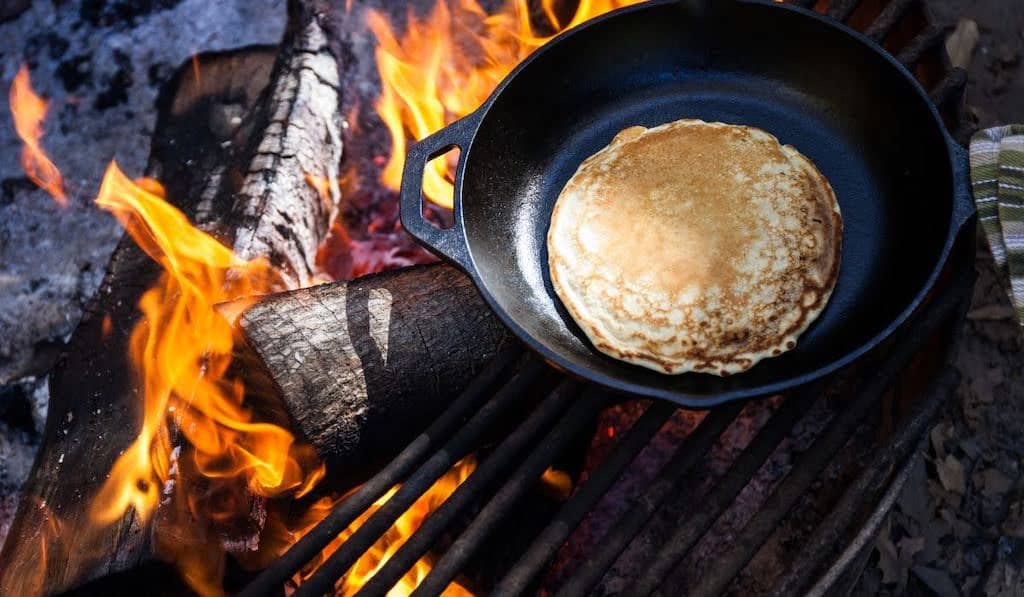
If you’re camping at a campground, there’s a good chance you’ll have a fire pit at your site that you can use for cooking, making s’mores, and telling ghost stories around. Campfires are a kid magnet and one of the most enjoyable parts of an evening at camp!
Before starting a campfire, be sure it’s allowed at the campground. During high winds or in extremely dry conditions, campfires may not be safe.
You can usually buy a bundle of firewood at the campground. Due to invasive pests that hitch rides on firewood, you should never transport wood from place to place.
Things to bring from home:
- Matches or a lighter
- Tinder: can be newspaper, or you can make firestarters by filling a cardboard egg carton with sawdust and pouring melted wax over the top. When you’re ready to start a fire you just break off one of the egg holders and put it under the kindling and firewood.
- A small hatchet
Fuel for your fire:
- Kindling: Small dry twigs, pine cones, birch bark, or other flammable material that catches easily.
- Fatwood: Slightly larger sticks that go on top of the kindling.
- Cordwood: Large pieces that will burn hot and keep the fire going.
Here’s how to get that fire started:
- Add a layer of tinder or your egg-carton firestarter to the bottom of the fire pit.
- Next, add a layer of kindling, tipi-style, so you get some airflow in the middle.
- Add a few pieces of fatwood on top of the kindling, also in tipi-style.
- Light the tinder/firestarter
- As your fire gets going, slowly add increasingly larger pieces of wood that will catch without smothering the flames.
Tips for cooking over a fire:
Your cooking campfire is different than your hanging-out campfire. For cooking you want to get your fire nice and hot and then let it burn down to red-hot coals without a lot of flames. If you’ve got a cooking grate, you can adjust it before adding your food.
Open-fire cooking is great for foil-wrapped meals, burgers, hot dogs, and my favorite — roasted corn on the cob. We find fires less reliable for boiling water for coffee, which we’re always in a hurry for.
Tips for Staying Warm and Dry in Your Tent
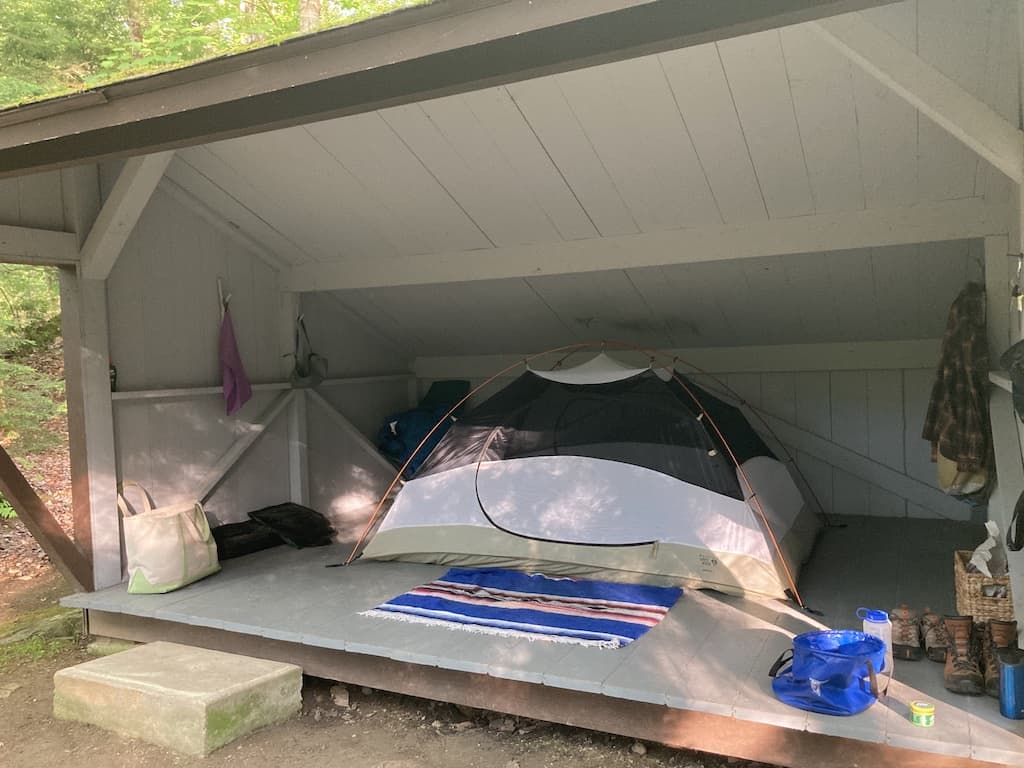
If you invest in a good tent, sleeping bag, and pad, and you’ve secured your rain fly nice and tight over your tent, you’ve already won half the battle.
Here are a few more tips to make sure you’re warm, dry, and cozy on your camping trip:
- Share your body heat. Invite your favorite sleeping partner to snuggle up. As long as they’re warm-blooded — dog, child, or partner, you’ll be cozier than if you were sleeping alone.
- Use a hot water bottle in your sleeping bag. Heat up some water over your campfire before bed. When it’s time to turn in for the night, pour the hot water into your Nalgene bottle and tuck it into the bottom of your sleeping bag for toasty toes.
- Do some jumping jacks before bed. Think it’s warm sitting around the campfire? That’s external heat that will disappear as soon as you walk toward your tent. Make your own heat by taking a minute to do jumping jacks or another type of exercise before hitting the sack.
- Use an emergency blanket to reflect heat. You can drape it over your sleeping bag if it’s really cold, or tape it to the inside of the ceiling of your tent.
Tips for Camping with Kids
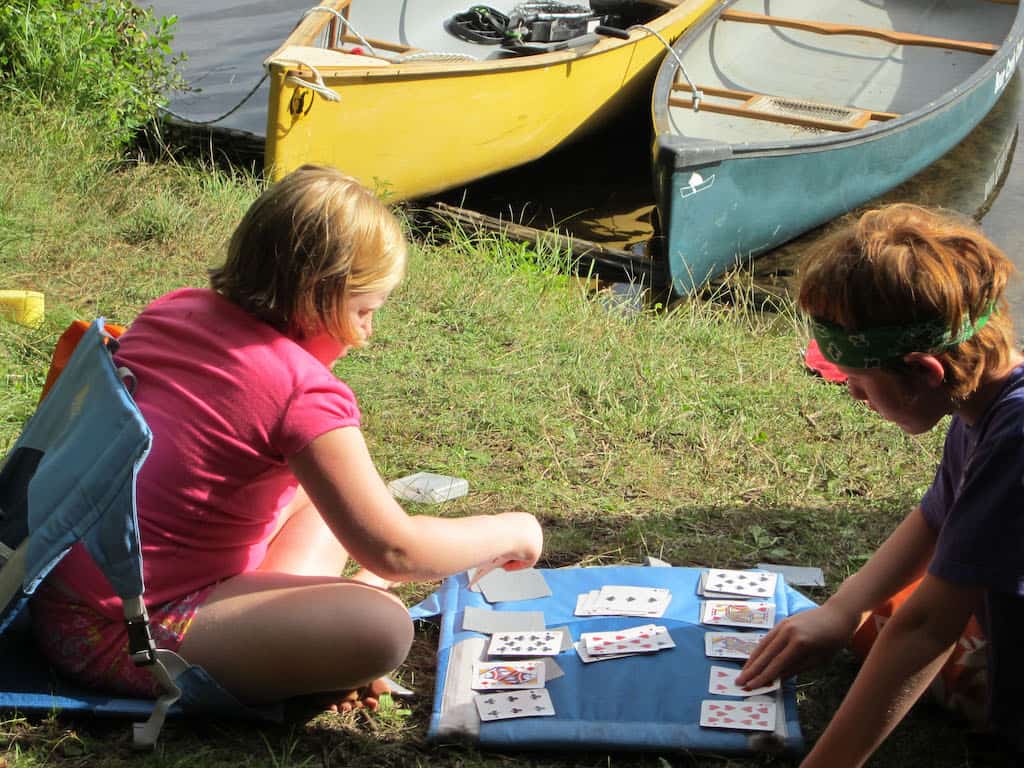
Our kids loved camping, and now that they’re grown, they still love it! Here are some tried-and-true tips for camping with kids based on our 20+ years of too many camping trips to count with our kiddos.
Give Your Kids Camping Chores
It is no fun doing all the work on our camping trip while your kids run around with their blissful outdoor voices and their scraped knees. Everyone should enjoy camping, and everyone should help out to make the trip a success.
When we camped with our kids, we would assign chores based on our kids’ skills and interests. Usually, one kid would help set up the tent and bedding while the other gathered firewood in preparation for the evening meal.
As they got older, the kids would be in charge of our two dogs and sometimes, creating the camp meal from scratch.
Finally, whoever cooked the meal that night got off dish duty, which is always a treat!
Give Them Freedom
As a parent, worrying is natural, and while there are certainly dangers outdoors, your kids will benefit from having the freedom to explore and navigate certain risks.
Teach your kiddos how to explore the outdoors safely, and as they mature and make good judgment calls, you can give them more freedom to do things independently around the campground.
I also recommend giving kids the freedom to be bored so that they’re forced to use their imaginations and come up with things to do. Those things will rarely be the same things you come up with, which makes it all the more exciting for them.
Extra Gear for Kids
Honestly, kids don’t need much extra gear for their camping trip. Yes, they need to be warm and dry like everyone else, so be sure your tent is big enough, or get them one of their own.
As with your adult gear, be sure that kids’ sleeping bags and pads are high quality and warm enough, and that they have their own headlamp for getting around in the dark.
Kids will likely need more clothes than adults, because they will obviously find every mud puddle to play in, and will thrill at the idea of getting soaked and dirty before bed. It’s all part of the fun.
Our Top Tips for Camping with Dogs
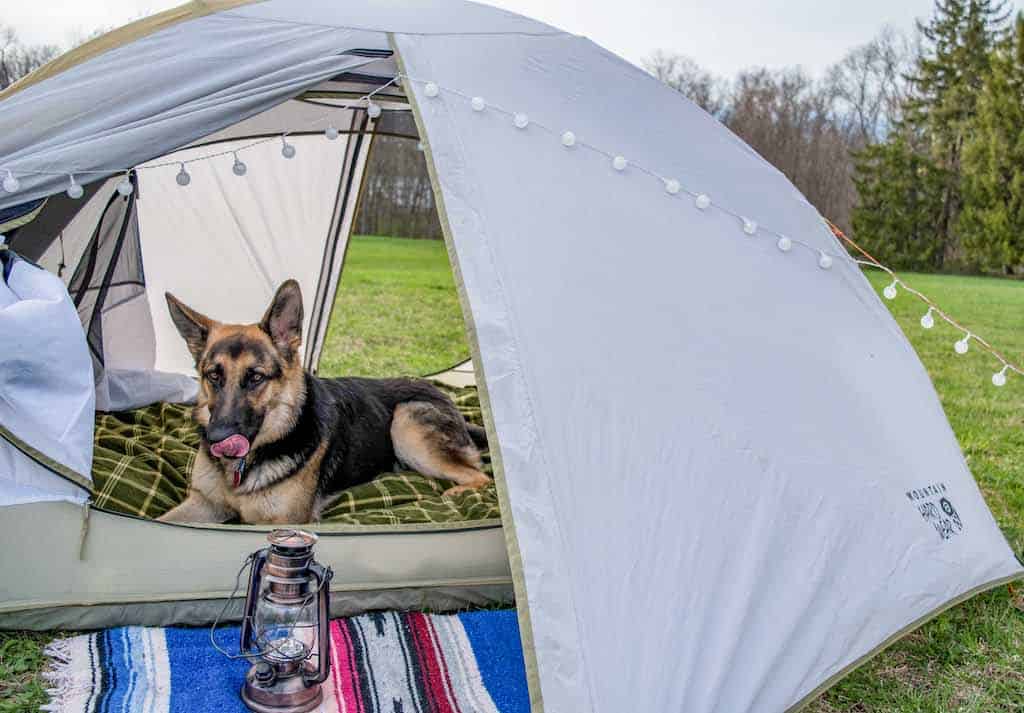
Now that our kids are grown and on their own, we have transferred all that extra affection to our dogs, Flynn and Malinda, and while Eric and I have camped lots without kids, I can’t actually think of many camping trips that we’ve done without dogs.
If your dogs could talk, I’m guessing they’d let you know that dog-friendly camping is pretty high up on their list of favorite things to do, right up there with chomping on juicy bones and rolling in dead stuff.
Camping with dogs does require a little extra planning on your part, which I promise will be worth it. Before you head out on your grand adventure, be sure you and your pup are prepared for your camping trip.
First, research your options for pet-friendly campgrounds to make sure your dog is allowed.
We’ve found national forests and many state parks in the US to be extremely dog-friendly, and although national forest campgrounds have fewer amenities, they are wonderful for getting off the beaten path when we travel with dogs.
Most national parks allow dogs in the campgrounds, but there’s a good chance that the trails will not be dog-friendly, which is why we stay away from most national parks when we’re camping with dogs.
Essential Items for Camping with Dogs
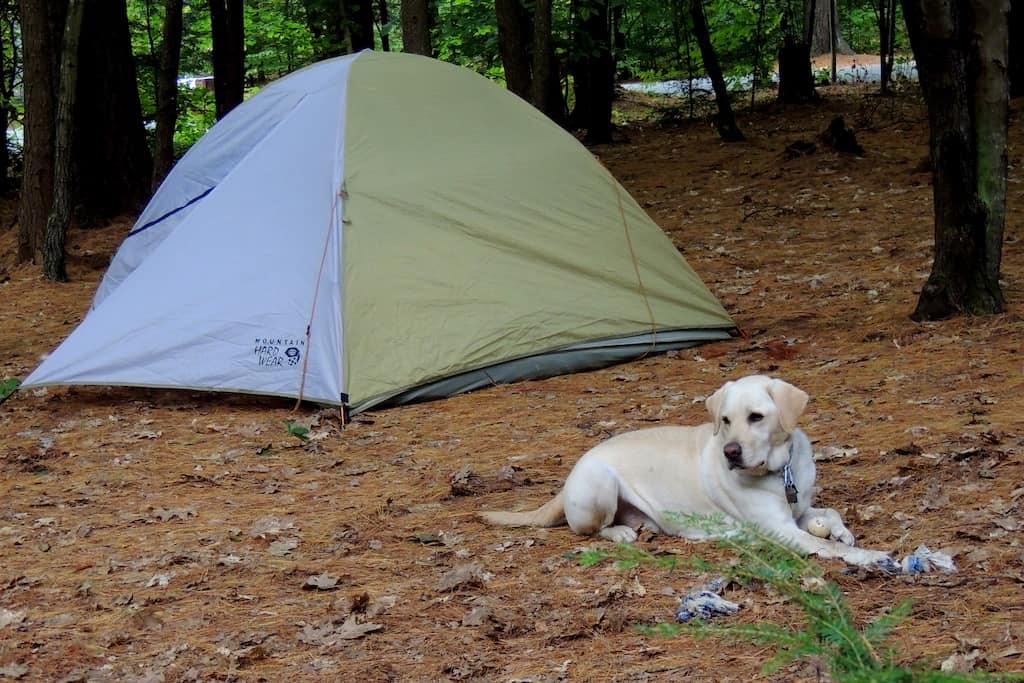
Your dog doesn’t need much gear to have a fabulous camping trip, but you’ll have to pack a few of the most important things to make the trip successful. Here’s a basic packing list:
- A food dish and a water bowl. Regular dog bowls are fine for this, but if you’re short on space, you can buy collapsible dog bowls that fold down flat and don’t take up much room.
- 6-foot leash for walking
- 10 to 30-foot leash for exploring and for tying out. Biothane leashes are awesome because they are waterproof, smell-proof, and resist getting all knotted up. We have a 16-footer and a 30-footer that we bring on every camping trip.
- A stake for tying out your dog at your campsite. Tie a colorful ribbon to the top of your tie-out stake so you don’t trip over it and don’t put it in the path to the bathhouse!
- Poop bags for clean-up. Very important if you want to remain on good terms with your camping neighbors.
- Enough dog food for the length of your trip. We use this roll-top bag for most camping trips. It holds 25 cups of food and is waterproof and smell-proof.
- Treats for training and rewards.
- A treat pouch. The one we love best is made by Doggone Good and hooks onto your waistband and holds training treats and poop bags.
- Outdoor dog toys, bones, etc. to keep your dog busy when everyone is relaxing around the campfire. If your dog has a favorite toy, be sure to pack it!
- Your dog’s bed. If you are short on space, try a portable dog bed. This one from Chuckit comes with its own stuff sack and is less than $20. The listing says up to 25 pounds, but we use it for our Labradors who are closer to 65 pounds.
- Old towels. Adventure dogs are usually dirty dogs. We try and clean the mud off of their paws before letting them in the tent for the night.
- Paw Wax. Something like Musher’s Secret is great for keeping your dog’s paws conditioned for outdoor adventures, especially on hiking trails with rough terrain.
Be sure to read our ultimate guide for camping with dogs, which goes into detail about gear, training, and camping with reactive dogs.
Important Campground Etiquette

We love just about everything about camping — late nights around a campfire, falling asleep to the sounds of the night, and listening from our sleeping bags as the birds sing their first morning songs.
There are a few things that can ruin a good camping trip, though, and rude and disrespectful camping neighbors are at the top of the list.
All that relaxing and connecting with nature that I just mentioned? It all flies out the window when you can’t fall asleep because the neighbors are partying in the next campsite over. Or you are constantly accosted by the “friendly” loose dog trying to steal your camp food.
Camping can be a fun outdoor adventure, but only if everyone plays by the same rules. Yes, there are rules. The good news is that the rules of camping etiquette aren’t hard to follow, and everyone appreciates a good camping neighbor.
Here are some tips for being a good camping neighbor:
- Abide by quiet hours for your campground
- Don’t walk through someone else’s campsite
- Keep your campsite clean to avoid attracting wild animals
- Follow Leave No Trace Principles
- Don’t move firewood!
- Don’t leave your campfire unattended
- Clean up after your dogs and your kids
Want to learn more about being good campground neighbors? Read this next: Camping Etiquette: Keep Your Neighbors Happy and Make Friends While Camping.
After reading this massive tome designed to help you get out the door to enjoy your first time camping, remember the most important thing: the more you go camping, the more you’ll enjoy camping, and the more you’ll want to keep going camping.
Camping takes a little bit of practice, but the more you do it, the easier it gets. See you out there!
Follow us on social media for more outdoor inspiration!

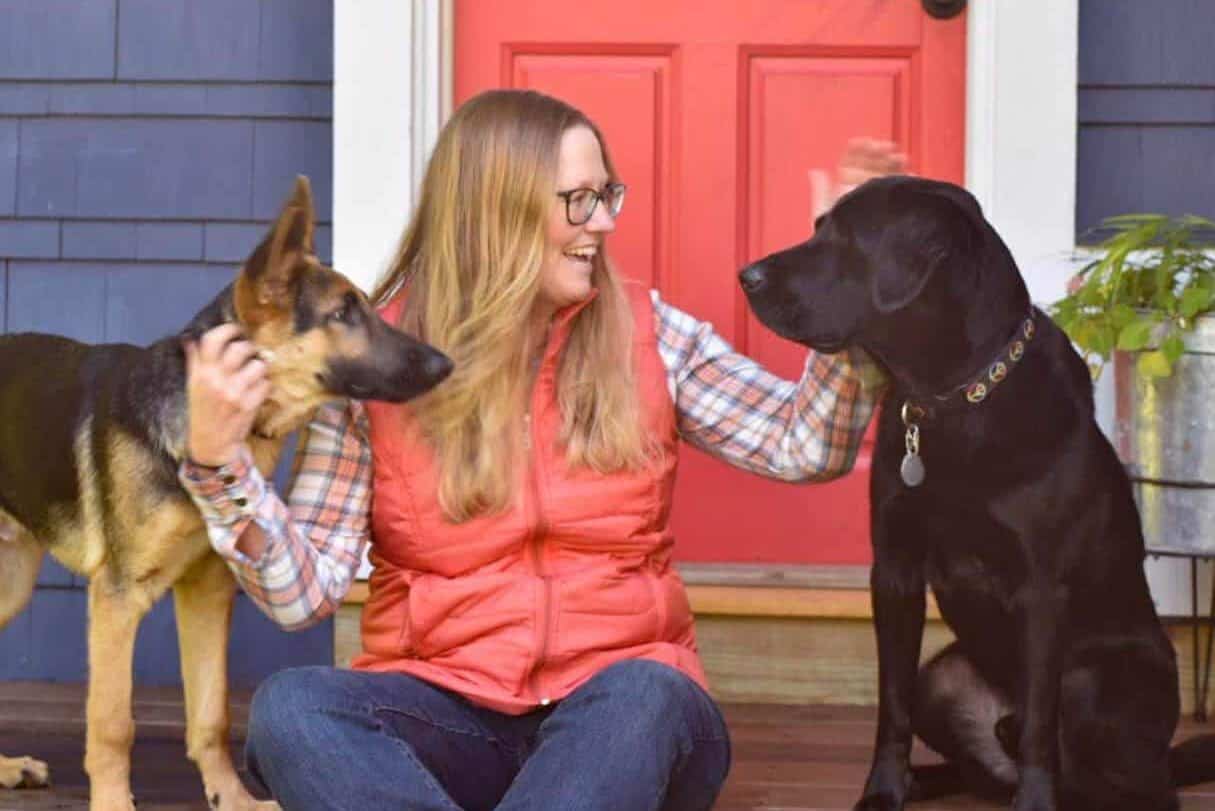
Tara Schatz is a freelance writer and travel blogger with a passion for outdoor adventures. She is the co-author of AMC’s Best Day Hikes in Vermont and currently blogs at Back Road Ramblers and Vermont Explored, where she shares travel tips, adventure destinations, and vacation ideas for the wanderer in everyone.


